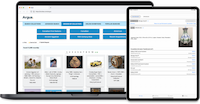How to Enhance the Museum Object Record with Immediately Available Information

Rachael Cristine Woody
This month’s series focuses on the enhancement of museum object data using “hidden” troves of information. Hidden is in quotes because the information exists and often is not hidden—it just hasn’t been gathered for inclusion in the museum Collections Management System (CMS).
This is because the information (and the field it corresponds to) falls outside of the minimum cataloging needed to meet best practice.
Data enhancement is a departure from normal operations, but it offers improved collection discovery and an increase in collection use. Last week, we considered the gaps in object cataloging and reviewed where the gaps live. This week, we’ll explore where sources of information currently exist and are available for immediate application to enhance object records.
Immediately Available Sources of Information
In a museum, there are many sources of information that could be applied toward object record enhancement. For today’s post we’ll focus on sources that don’t require much original research, and instead outline sources that could be easily incorporated into data enhancement work. The following are common and immediately available informational sources:
- Accession paperwork
- Articles
- Books
- Encyclopedic references
- Exhibit catalogs
- Previous card catalogs or inventories
- Scholarly work
Where to Find the Sources of Information
As helpful as these museum resources are, they are often dispersed and many staff may not know where they’re kept. For each source, here are suggestions for where to start looking:
Accession paperwork: These files can live in several places. The most obvious suspects for physical files are:
- Museum archives
- Registrar/Collection Manager office
- Executive Director office
- Object storage
There may also be digital files. In which case, access to electronic file storage will be needed. These files could live in a specific area of the server or cloud storage. The good news is that as long as you have permission to view those file types, you should be able to perform a search for them.
Articles, Books, and Scholarly works: There are a few places these works can exist. For the physical sources check:
- Museum library
- Curatorial office
- Registrar/Collection Manager office
These sources will also exist in digital format and can be accessed by the museum or local library catalogs and scholarly subscriptions.
Auction catalogs: These sources may be kept near or with the accession paperwork. They may also be referenced with an inquiry to the auction house.
Encyclopedic references: These sources are almost exclusively electronic. If a subscription is needed, they can be access by the museum library or local library.
Exhibit catalogs: If it’s an in-house publication, these can be accessed via:
- Museum library
- Curatorial office
- Registrar/Collection Manager office
- Exhibitions office
Previous card catalogs or inventories: If these exist there are two primary places to look for them:
- Museum archives
- Registrar/Collection Manager office
It may take a little bit of searching and inquiry to ascertain the location for each source. The good news is that once you find these sources you can locate and access them easily each time you wish to work on data enhancement.
Where to Apply the Information
The next step is to determine where this information is best captured in the object record.
Accession paperwork: Can inform the accession record, provenance, past purchase price, and condition.
Articles, Books, and Scholarly works: Can inform provenance, description, materials, techniques, style, and related items.
Auction catalogs: Can inform description, materials, techniques, style, and related items.
Encyclopedic references: Can inform description, materials, techniques, style, and related items.
Exhibit catalogs: Can inform description, materials, techniques, style, and related items.
Previous card catalogs or inventories: Can inform provenance, description, materials, techniques, style, and related items.
Conclusion
After the review of data gaps and an assessment of where to find immediately available sources of information, data enhancement work can begin. For a deeper dive into where additional hidden troves of information can live, tune in next week to learn where to find new information and consider its application to enhance object record information.
Additional Reading

Rachael Cristine Woody
Energized by this post? Please join us for the companion webinar, Enhance Museum Collections Online with “Hidden” Troves of Information, on October 30, 2024 at 11 a.m. Pacific / 2 p.m. Eastern. (Can’t make it? Register anyway and we will send you a link to the recording and slides afterwards). Online registration opens soon or call 604-278-6717.
**Disclaimer: Any in-line promotional text does not imply Lucidea product endorsement by the author of this post.
Never miss another post. Subscribe today!
Similar Posts
Exploring No-Code Digital Storytelling: Hoover’s “Fanning the Flames” Exhibit
Explore no-code digital storytelling with Hoover’s ‘Fanning the Flames’ exhibit. See how interactive tools (Deep Zoom Color Compare & Hot Spot) enhance user engagement and the visual experience.
An Introduction to Scrollytelling for Museums
Discover how museums use scrollytelling and digital storytelling platforms to create immersive narratives. This introduction explores key concepts and approaches to interactive storytelling.
Exploring Self-Determinate Multiple Pathways: An Example of Digital Storytelling
Discover how self-determinate multiple pathways offer flexible interactive storytelling in museum exhibits. Learn from the Tenement Museum’s ‘Your Story Our Story.’
Digital Museum Storytelling Example: A Look at Self-Determinate Linear Pathways
Self-determinate characteristics on a linear pathway go beyond brief sidebar topics and instead offer alternative ways to navigate the linear pathway.







Leave a Comment
Comments are reviewed and must adhere to our comments policy.
0 Comments